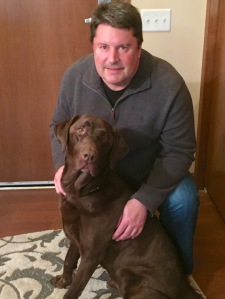Removing clots provides additional benefits for stroke patients compared to medications alone
HCMC patients enrolled in study that shows clot-busting medications aren’t the only options in stroke care
 Taking his dog out for a walk left Richard Juergensen speechless – but thanks to a life-saving technique and the quick actions of a neighbor, the 55-year-old survived a stroke and is already back to work.
Taking his dog out for a walk left Richard Juergensen speechless – but thanks to a life-saving technique and the quick actions of a neighbor, the 55-year-old survived a stroke and is already back to work.
On the chilly -8 below evening of Tuesday, March 4, Juergensen and his chocolate lab, Bear (see photo) began their evening routine going outside for a walk. After Bear made a pit stop in the front yard, Richard remembers his arm suddenly going numb. “I grabbed hold of my arm and it was just kind of flopping around,” he explains. “Then my right leg went numb, too. A neighbor saw me and asked me what was wrong, but I couldn’t answer him. I knew what I wanted to say, but couldn’t say it.”
His neighbor quickly called 911 and Hennepin EMS paramedics recognized his symptoms as a likely stroke so notified the hospital of a “Stroke Alert” and transported him to Hennepin County Medical Center, where he was evaluated by their stroke team. “When I was in the emergency department I felt like giving up because people were asking me questions and I knew the answers, but couldn’t articulate them,” said Juergensen. “It was very scary.”
He was found to have an occlusion – a clot – in one of the branches of the middle cerebral artery in his brain and was immediately taken to an interventional radiology suite, where the clot was removed using a Solitaire™ stent retriever and a special suction device called Penumbra™. Because Juergensen was on blood thinners, he could not receive the clot-busting medication, alteplase (also known as tPA), leaving him mechanical thrombectomy as his only treatment option.
“As the only Minnesota hospital to enroll patients in any of four recent research studies about whether clot removal using state-of-the-art devices is as beneficial as IV tPA, we were in a perfect position to treat Mr. Juergensen,” explains HCMC’s Dr. Bharathi Jagadeesan. “The research trials demonstrated that this technique works, and that clot-busting medication isn’t the only answer.”
In fact, if mechanical thrombectomy (blood clot removal) is performed, patients have a longer window of time to receive treatment and more patients have a good outcome when compared to clot-busting medication therapy alone.
“IV tPA, or clot-busting medication, is still our first-line therapy; however, it must be administered within 4.5 hours of the onset of stroke symptoms and is not safe in patients with a significant bleeding risk, like Mr. Juergensen,” said Dr. Jagadeesan. “So if the patient cannot be given IV tPA or if stroke symptoms persist after tPA is started, it’s great to know that we have the specialized equipment and highly skilled interventional team that are needed to successfully perform mechanical thrombectomy.”
“When I woke up Wednesday morning, everything was back to normal,” said Juergensen. The night before I thought my life was changed forever. Now words can’t express how grateful I am for the care I received.”
Juergensen was discharged from HCMC on March 6, just 3 days after having what would most likely have been a major stroke if he hadn’t received emergency treatment. He returned to work a week later.
“Mr. Juergensen is an excellent example of the life-saving and life-changing outcomes that can be achieved with prompt and precise medical intervention,” said Dr. Jagadeesan.
The Hennepin Stroke Center at Hennepin County Medical Center is a national leader in the treatment of ischemic and hemorrhagic strokes with some of the fastest clot-busting drug delivery times in the U.S. HCMC is the only hospital in Minnesota who enrolled patients in the SWIFT-PRIME stroke trial which demonstrated improved outcomes in patients receiving IV tPA plus cutting edge endovascular therapy compared to patient’s receiving IV tPA alone. The Hennepin Stroke Center is nationally certified by the Commission on Accreditation of Rehabilitation Facilities (CARF) for rehabilitative care after a stroke occurs.

